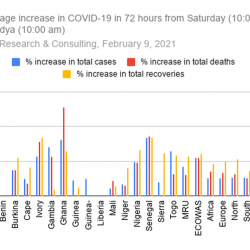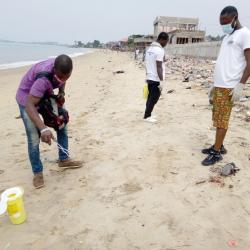By Joseph Bankole Thompson MD, PHD
Sierra Leone recorded 0.37% and 1.33% increase in COVID-19 total cases and total deaths respectively in 48 hours, from Tuesday (10:00 am) to Thursday (10:00 am).

By Joseph Bankole Thompson MD, PHD
Sierra Leone recorded 0.37% and 1.33% increase in COVID-19 total cases and total deaths respectively in 48 hours, from Tuesday (10:00 am) to Thursday (10:00 am).

By Joseph Bankole Thompson MD, PHD
Sierra Leone recorded 0.80% and 2.48% increase in COVID-19 total cases and total deaths respectively in 72 hours, from Saturday (10:00 am) to Tuesday (10:00 am).

By Kemo Cham
Along Levuma Beach in the west end of Sierra Leone's capital, Freetown, a group of volunteers carefully scavenge a long stretch of piles of rubbish, looking for syringes and hypodermic needles randomly dumped by drug users.
The volunteers scratch through the debris, collect and carefully drop the syringes into boxes, one at a time.

By Joseph Bankole Thompson MD, PHD
Sierra Leone recorded 1.62% and 1.60% increase in COVID-19 total cases and total deaths respectively in 48 hours, from Thursday (10:00 am) to Saturday (10:00 am).

By Alimamy Jalloh
Of the 3,298,626 working age Sierra Leoneans in 2018 only 227,856 contributed to the National Social Security and Insurance Trust (NASSIT), which is the national retirement scheme, according to data published on NASSIT’s website.
The 2018 Sierra Leone Integrated Household Survey (SLIHS) reveals that, 2,129,972 working Sierra Leoneans were employed, including those that are self-employed. This means that about 93% of the people would not have a safety net for their retirement age.

By Alhaji U. N'jai
In Africa, curfews and lockdowns as measures to contain Covid-19 infections may in fact help to spread the virus among the population rather than slow it down.
Based on real-time anthropological observations and review of the current science around the virus, over 90 percent of infections happen indoors or in confined spaces.